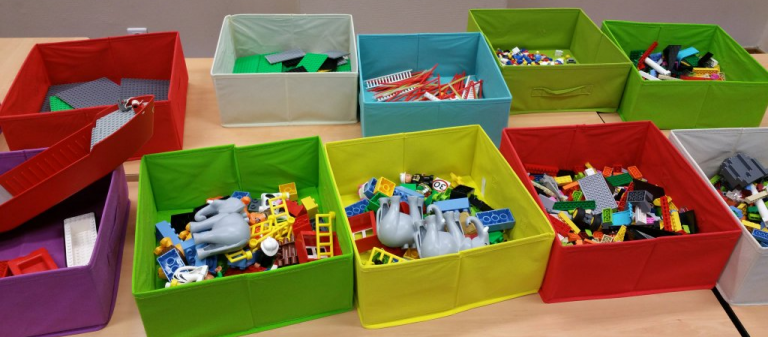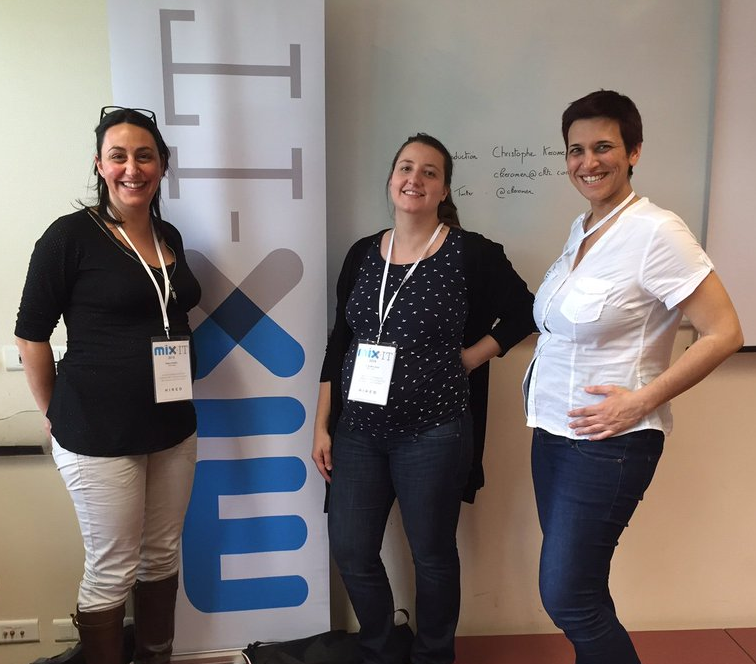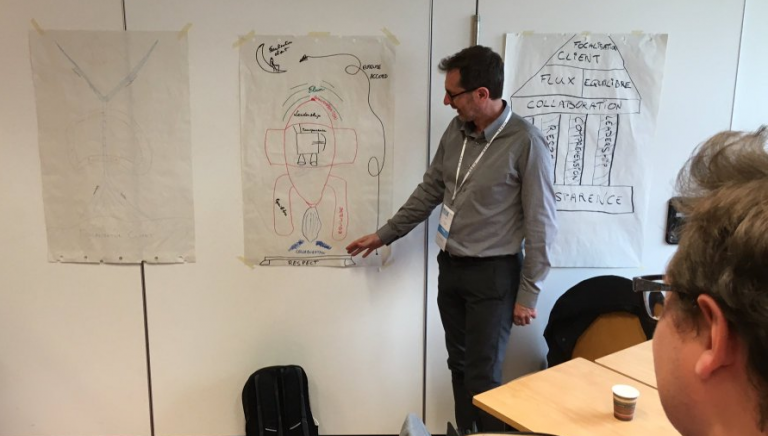During these two days, I could feed myself on talking with other members from the agile community and also on second thoughts rising from the sessions I attended. As Lyon is a good place to live and is labelled the capital of gastronomy, I also fed my body thanks to nice treats from the organizing team pampering participants and speakers as well!
1ST DAY
TEACHING SKILLS AND AGILITY BY CHRISTIAN DEN HARTIGH
April 21st began by two keynotes. First, Christian Den Hartigh talked about teaching skills and agility. Christian is a French teacher in a junior high school located in a priority education area.
For Christian his mission is to “do as less damage as possible”. Christian is an innovative teacher who discovered agility in 2009. In the Agile Manifesto he discovered similarities with teaching: interactions rather than methods, adapting to change rather than following a plan (or a syllabus!), collaborating with pupils rather than negotiating… He has also adopted practices and tools, such as the kanban. By the way, as he expresses it so clearly:
'Management is teaching skills for adults; teaching skills, it’s management for kids.
I fancied “the anger paper” idea put up in class and labeled “To crumple and throw in case of anger”.
To copy within the company!'
SELF-CONFIDENCE: IT’S NO USE BY LAURE JOUTEAU
Secondly Laure Jouteau talked about self-confidence or rather about the lack of self-confidence. Laure has set up Les aventurières to back up women during their career change: she describes herself as a Liberating Genius. I loved this session for Laure’s natural temper and her dynamism, her humour and her sense of self-derision (talking about her panties in front of 600 people, is not that easy for everyone!) and the pertinence of what she told us. She explained that our self-confidence is limited to the things we have already done and that it’s normal to be afraid when faced to fulfil our dreams. Otherwise those are not dreams, they are memories. She took the example of stress she felt when going up on stage to perform this keynote. And as my session was following hers, it helped me overcome my stress focusing on the positive aspects: I was fulfilling a dream!
FEEDBACK ON OUR AGILE PRACTICE WITH OUR KUZZLE TEAM
In this session I shared the agile feedback on Kuzzle team. The slides (in French) are available on Slideshare.

As I have explained in this Blog article in our Kuzzle team we do not use any “official” agile method. We have built our tailor-made method, we improve it according to our situation and our needs. The rules we follow are: respect our values (really close to agile values) and remain pragmatic. We started from a single practice: retrospective, which enabled us to bring about other practices and tools useful to the team as needs arise. We’re keen to refactor or even to get rid of a practice or a tool no longer suitable. That’s why our method is “lean” i.e. without waste. I illustrated how this approach goes on as regards: collective property of architecture, sharing responsibility within the team (zooming on The Bus Factor), recruitment and integrating new members. Our team has managed to grow from 4 to 12 people within less than a year and I’m convinced that it’s thanks to this approach that we manage to grow while remaining agile.
Phew! Once my session was over I could happily enjoy the rest of the conference. Besides talking to several participants, on agility, recruitment, about Kuzzle, I mainly took part in “track agile” workshops.
A WORKSHOP TO (RE)DISCOVER THE AGILE MANIFESTO
Romain Couturier has led a Lego Serious Play workshop to (re)discover the agile manifesto. In this workshop participants express themselves mainly thanks to Lego structures to answer questions on the agile manifesto.

Participants are divided up into mixed level teams. They work out their answers to the first questions individually and share them with the team. Then the team works out common answers and we do build an answer common for all the participants. Here is what I remember most from this workshop:
- We can say stacks of things with Legos.
- It’s difficult to choose elements (values or principles) from the manifesto and accept to move aside others as they’re altogether consistent.
- The manifesto is broad enough to be prone to be adapted.This workshop allows to broaden your point of view through the interpretation of other participants.
- Most of the participants talked about values, only a few were sticking to practices and tools.
- That’s what makes the final merging more difficult: during the workshop, we reached a common understanding at the team level; however all the teams do not have much time to share these understandings before expressing them through an only one structure. During this stage, the natural leaders (leaders by ideas, leaders by actions) lead operations.
I really liked this workshop. Beyond the fact that Romain successfully brightened it up being “flexible and firm”, the workshop was fun and enabled me to discover new ways to tackle the agile manifesto with novice agilists. I really liked the discussion that took place within my team on the fact that confidence is a necessary prerequisite to set up the agile manifesto within a team and a project.
A WORKSHOP ON KANBAN VALUES
I moved on to Olivier My’s workshop on Kanban values. I was delighted to see that the will to return to the roots and values of agility was shared by several of my colleagues
Funny anecdote: on 4 people, our team was made up of three pregnant women (me included):

This workshop was worked out by Mike Burrows and translated in French by Christophe Keromen. In this workshop, each team had to communicate to link up each Kanban founding principle and each core practice to the 9 Kanban values. The purpose of this exercise lies in the fact that each principle can be linked to several Kanban values. Through discussions and exchanges the team should choose which -according to their opinion- is the predominant value for each element. Then we’ve been thinking about the practical case of one team member to determine which 3 values he should work on first according to his own specific issues. At last, each team built its graphic presentation of the 9 Kanban values. Down below you can see maps drawn by the teams:

2ND DAY
The following day, I went on alternating between sessions and talks with my colleagues. I especially liked talking with Stéphane Langlois about recruitment 3.0 (i.e. recruitment at the era of management 3.0).
RANDOM SESSIONS: A NEW CONCEPT AT THE MIX-IT
This year the MIX-IT offered a random session just at the end of lunch break. Several sessions at the same time not described in the program and where participants were randomly splitted up. It’s a real challenge for speakers who have to captivate an audience who didn’t choose to come and listen to them. For participants, it’s a way to broaden their perspectives while discovering a topic they ignore or know little about. As for me, I attended a session about software kraftmanship meant to explain why setting up practices about code quality should not be considered as a pool of costs but rather as an investment bearing its fruit in the medium term.
MOVING MOTIVATORS, A SERIOUS GAME BY JURGEN APPELO, ORGANIZED BY ROMAIN VIGNES
I ended my MIX-IT 2016 by the workshop of Romain Vignes: sans motivation pas d’action ! [without motivation no action!]. It’s a workshop using the serious game Moving Motivators from Jurgen Appelo exploring intrinsic motivation factors. Romain gave us some solutions to identify our own main motivation factors. For example, here are mine classified in order of importance (the most important is on the right).

We have also seen that beyond knowing our own motivation factors, it was interesting to share these motivation factors with the team and to deduce the motivation factors of the team. This enables to ease collaboration, but also recruitment and integration of newcomers. For example, if a team ranking first “Order” recruits a person whose important factor is “Freedom”, it’s good to identify it at the soonest and talk about it. A solution could be, for example, to set up rules defining the area of autonomy for each person. Thus, we can please everyone.
'I finished this workshop with many ideas
and even today I find new situations to use it!
In short a workshop with a high ROTI for me ?'
I CAN’T WAIT FOR NEXT YEAR!
That’s how ended my MIX-IT 2016. On my way back in the train I felt replete. I was tired, but it was a nice tiredness. I had spent two days well filled in, talking with people I really like and discovered more. I learnt many things, I expanded my facilitation and management toolbox! And furthermore I had a great time. I look forward to go back next year and to be sure to get the right to go back I’m already thinking about the topic I could present!
